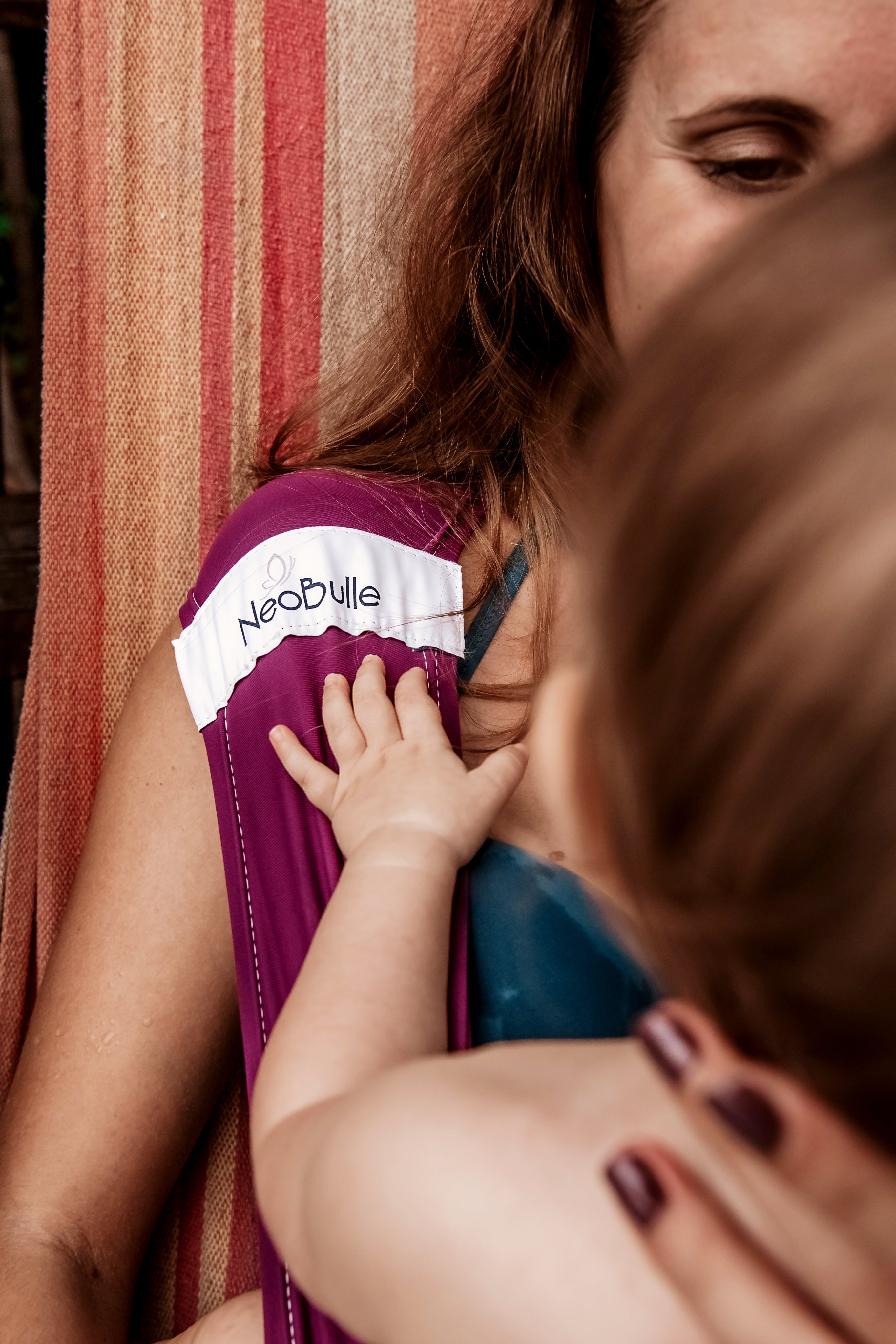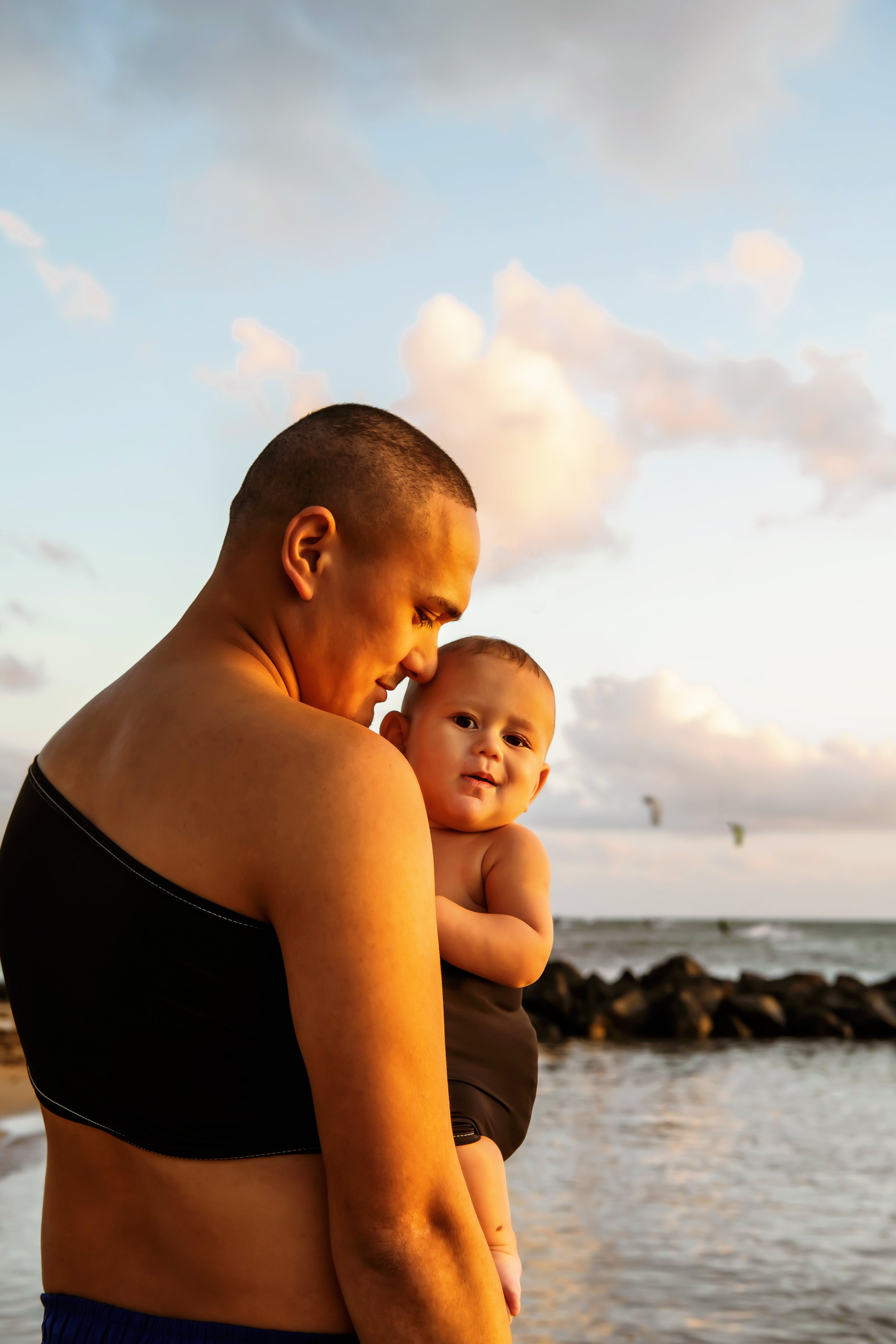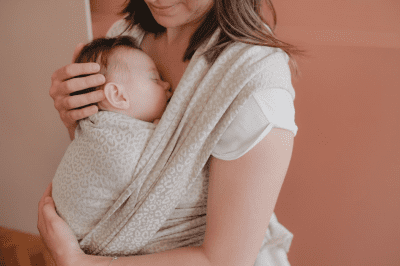Article 2 : Carrying a Baby Suffering from Reflux
After discussing daily life with a child suffering from GERD in the first article of this topic, the following article will be dedicated to the specificities of carrying that reflux induces.

Between theory and practice…
In the frequent advice regarding supporting a baby with reflux, it is recommended to keep the baby vertical as much as possible, and to carry. On paper, carrying is ideal because it calms stressed babies, promotes falling asleep, offers a vertical posture, liberates the parent's arms, and so on...
That’s the theory.
In practice, it’s another story! Babies suffering from reflux have an instinctive NEED to be carried, but very often CAN’T STAND IT! They want to be held, cuddled and reassured... But they don’t tolerate contact. Moreover, being extremely stiff, the setups are more complex (not to say sometimes downright acrobatic).
You’ve understood from these few lines, practical life is not straightforward!

The vicious circle of hyperextension
The first difficulty in carrying is hyperextension, and the manipulation challenges it causes! Be careful, GERD does not have a monopoly on hyperextension; many other factors can promote this (such as torticollis, for example). We discuss this here in the context of supporting a baby suffering from reflux because it is one of the major difficulties that can be encountered, but the following advice applies regardless of the initial cause.
Babies who suffer from reflux are generally described as very tonic babies... This is often related to hyperextension, and it has nothing to do with a possible “advance” in psychomotor development.
The normal (by standard) posture of a little one is a flexible and curled-up posture, with the back more rounded (see physiological position). When hyperextension occurs, the baby becomes very stiff, adopting straight postures (or even arched), in the jargon of carrying sometimes called a “stilted baby”.
One might think that these "thrown back" postures are pain-relieving for the very young, that they help relieve some of their pain by relaxing the stomach and reducing the occurrence of reflux, but in fact no, it's quite the opposite! They are actually reflex positions in response to pain.
To put it simply, we confuse cause and effect, the baby does not arch to hurt less, it arches BECAUSE it is in pain.
Since we mistakenly believe (incorrectly) that keeping the body straight will make our little one hurt less, we naturally allow them to settle into this position, or even encourage it. This leads to 2 things:
1/ more complicated digestion (if you remained yourself in an arched position after a meal, you would see that it’s not very helpful for digesting properly), which itself is a vector for acid reflux if you followed along...
2/ a postural habit combined with excessive contraction of the dorsal muscles, which will prevent your little one from returning to more upright postures (kind of like having a too tight elastic pulled in their back).
And thus the vicious circle.
The hyperextended posture is also problematic on other levels that we will not detail here.
But you might say, that’s all very nice, but what do we do to address this and correct it?

Supporting rolling over daily
The first thing to do is treat the pain (see the first article in the reflux series).
Then, daily, we will ensure to gently work on the "good" postures, while limiting as much as possible all movements likely to re-induce hyperextensions (and you will see that they are numerous!).
Thus, we will avoid anything that stimulates your little one to "arch" backward, such as for example:
- A mobile above their head (preferably an installation closer to their feet)
- Toys behind their head
In the arms, we will also be careful to avoid anything that could encourage them to arch, especially by using the forearm instead of the hand to carry them. Indeed, when using the hand, or if the forearm is placed too far behind the hips, it creates a pressure that pushes their pelvis forward instead of inviting them to sit.




In short, it’s as if someone told him "throw yourself backwards," and at that age, well, they listen to what we say!
This can be seen as a true re-education, both in terms of the parent’s gestures and the overall posture of the child.
NB: In a physiological position, the stomach is not supposed to be compressed. If the baby is not "tucked" or "faced down," his stomach remains free.
And what about carrying in all this?
Carrying is coming into play. We saw that it can be more delicate to implement due to the stiff postures of the very young child. The other complex aspect is the tolerance of the baby, especially when the pain is not yet relieved.
As with anything that touches on somewhat specific needs, it is difficult to draw generalities, and you will need to do several tests to find the tool that best suits your little one, and arm yourself with a bit of patience!
The following tips are those that seem appropriate for the majority of babies suffering from reflux, but unfortunately do not constitute a magic wand that works every time!

Choosing and adjusting your system
The choice of system should take into account both the needs of the baby and the ease of the carrier.
For the baby, generally, we prefer very stable and not too constraining systems.
For the carrier, we will prefer systems that can be easily installed even with a crying and stiff baby (we understand…)
You understand, the babywearing sling (especially stretchable) is clearly not the number 1 choice! It can be poorly tolerated by your little one (too tight, wrapping), and requires a great mastery to be properly installed when he is in crisis.
Systems like mei-tai or preformed are often better tolerated because they are less constraining, and they have the huge advantage of having material between the legs. To understand: when the little one is stiff as a board, crying and flailing, it is still possible to install him in the baby carrier even for a novice… The installation will be completely missed according to usual physiological criteria, but he will be safe!!!! And this will allow you to quickly walk and soothe him without overloading your body. Once calmer, it will always be possible to adjust the settings.
...The sling is also a system that, in some cases, works well, especially because it allows for a very gradual installation that is better tolerated by children.
If you are using a sling or a wrap, a good tip is to start adjusting from the bottom edge, rather than from the top as is usually done. You will probably notice but often it is the adjustments and transitions of fabric around the neck and shoulders that trigger tears: by starting to tighten around the pelvis, it will help your little one get used to it gently. Do not hesitate to take breaks after each adjustment, and to walk and rock your baby so that he can relax before moving on to the next adjustment.

Accept imperfection
Last but not least: despite everything discussed in these 2 articles, it is very likely that your little one will not adopt very “conventional” positions in their carrying system.
Forget about the baby bump, with knees well up and back nicely rounded… Sometimes when you manage to get a 90° angle (or nearly) between the thigh and the back, you are super happy and know that it will be difficult to do better!
And honestly, it’s not a big deal! What matters most is that your baby’s needs are respected, and that you can breathe a little too and/or attend to some tasks with your hands free… Are the airways clear? Is there a risk of falling? Then everything is perfect.

All that’s left is to put all this into practice! Don’t hesitate to also get support from a carrying coach to help you and adjust the carries to your specific situation. Courage and stay the course! You are the best parents you can be for your baby, reflux is fortunately not eternal and with your good care and his growth, things will eventually become easier.





